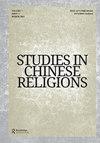道家仪式中拟人意象的引入
IF 0.3
3区 哲学
0 ASIAN STUDIES
引用次数: 0
摘要
摘要从早期天师群体到五世纪陆秀晶的礼教系统化、经学系统化,三个世纪的道教礼教是一种永恒的礼教。天师团体和灵宝经的仪式规程根本没有标志性图像的用途或位置。道教简编《武商要略》中仍然是这样無上秘要, 公元570年代末,在北周武帝的授意下编纂而成。然而,雕像是道教仪式的一个组成部分,正如七世纪早期的仪式简编《三东丰岛克杰》中所述三洞奉道科戒. 道教造像是何时何地出现的?它们是如何被接受并融入正统道教仪式的?本文追溯了雕像和标志性意象在道教仪式中的引入,以及标志性意象的使用所带来的仪式实践的变化。本文章由计算机程序翻译,如有差异,请以英文原文为准。
The introduction of anthropomorphic imagery in Daoist Ritual
ABSTRACT Daoist ritual during the three centuries between the early Celestial Master community and the systemization of ritual and textual canon in the fifth century by Lu Xiujing was aniconic. The ritual protocols of the Celestial Master community and of the Lingbao scriptures simply had no use or place for iconic imagery. This remains the case in the Daoist compendium Wushang biyao 無上秘要, compiled at the behest of emperor Wu of the Northern Zhou in the late 570s. Yet, statues are an integral part of Daoist ritual as presented in the early seventh century ritual compendium Sandong fengdao kejie 三洞奉道科戒. Where and when did Daoist statues appear? How were they accepted and incorporated into orthodox Daoist ritual? This article traces the introduction of statues and iconic imagery into Daoist ritual and the changes in ritual practice entailed by the use of iconic imagery.
求助全文
通过发布文献求助,成功后即可免费获取论文全文。
去求助
来源期刊

Studies in Chinese Religions
Arts and Humanities-Religious Studies
CiteScore
0.20
自引率
0.00%
发文量
10
 求助内容:
求助内容: 应助结果提醒方式:
应助结果提醒方式:


